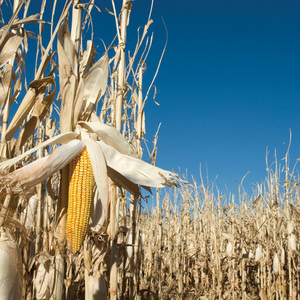USDA trims corn crop size in WASDE report, though still a record

January 12, 2015
BY Susanne Retka Schill
USDA lowers its estimation for corn yield in the January supply/demand report by 2.4 bushels per acre, for a national average of 171.0 bushels per acre. A slight increase in harvested acres gains some of that back, but total corn production was dialed back by 191 million bushels – still a record at 14.216 billion bushels from 90.6 million planted acres.
Projected ethanol use is increased 25 million bushels for corn over last month’s report, for an estimated 5.175 billion bushels bound for ethanol and distillers grains production. That mostly offsets a reduction in expected sorghum use for ethanol, due to strong prices expected from this year’s export demand for sorghum.
Total projected corn use for the current marketing year is reduced 75 million bushels with lower feed and residual use reductions of 100 million bushels, only partly offset by the increase in corn use for ethanol production. The reduction in projections for feed and residual use reflects the smaller crop and the September-November disappearance as indicated by the Dec. 1 stocks report. Corn ending stocks are projected 121 million bushels lower. The projected range for the season-average corn farm price is raised 15 cents on each end to $3.35 to $3.95 per bushel.
Advertisement
Advertisement
Sorghum production is raised 25 million bushels with increases estimated for both harvested area and yield. Sorghum exports are raised 40 million bushels. Domestic sorghum use is lowered 10 million bushels with a reduction in food, seed, and industrial use partly offset by higher feed and residual use. The sorghum farm price range is raised 30 cents on each end to $3.50 to $4.10 per bushel and higher than the projected corn price because of the large share of use coming from exports this year.
Global coarse grain supplies for 2014/15 are projected 3.7 million tons lower as a result of this month’s reduction in the U.S. corn crop. India corn production is raised 1.0 million tons with higher-than-expected plantings reported for its winter crop. EU corn production is raised 0.4 million tons with higher production reported for Spain, Croatia, Hungary, and Bulgaria. Offsetting these increases is a 0.4-million-ton reduction for Brazil sorghum with lower expected area.
Global coarse grain consumption for 2014/15 is reduced slightly as lower domestic use in the United States is mostly offset by higher corn use for Ethiopia, EU, India, and Canada. Sorghum consumption is raised for China, but lowered for Brazil and Japan. Sorghum exports are raised for the United States and imports are raised for China but lowered for Japan.
Advertisement
Advertisement
Global coarse grain ending stocks for 2014/15 are lowered 3.3 million tons mostly on lower projected corn stocks in the United States. Corn ending stocks are also lowered for Argentina with an increase this month in 2013/14 exports.
Related Stories
The U.S. EPA on July 8 hosted virtual public hearing to gather input on the agency’s recently released proposed rule to set 2026 and 2027 RFS RVOs. Members of the biofuel industry were among those to offer testimony during the event.
The USDA’s Risk Management Agency is implementing multiple changes to the Camelina pilot insurance program for the 2026 and succeeding crop years. The changes will expand coverage options and provide greater flexibility for producers.
The USDA’s National Agricultural Statistics Service on June 30 released its annual Acreage report, estimating that 83.4 million acres of soybeans have been planted in the U.S. this year, down 4% when compared to 2024.
SAF Magazine and the Commercial Aviation Alternative Fuels Initiative announced the preliminary agenda for the North American SAF Conference and Expo, being held Sept. 22-24 at the Minneapolis Convention Center in Minneapolis, Minnesota.
Scientists at ORNL have developed a first-ever method of detecting ribonucleic acid, or RNA, inside plant cells using a technique that results in a visible fluorescent signal. The technology could help develop hardier bioenergy and food crops.
Upcoming Events










